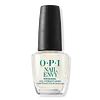What's inside
What's inside
 Key Ingredients
Key Ingredients

No key ingredients
 Benefits
Benefits

No benefits
 Concerns
Concerns

 Ingredients Side-by-side
Ingredients Side-by-side

Ethyl Acetate
PerfumingButyl Acetate
MaskingNitrocellulose
Propyl Acetate
PerfumingTosylamide/Formaldehyde Resin
Isopropyl Alcohol
SolventTriphenyl Phosphate
Trimethyl Pentanyl Diisobutyrate
N-Butyl Alcohol
PerfumingFormaldehyde
Stearalkonium Bentonite
Gel FormingCamphor
MaskingDiacetone Alcohol
MaskingEthyl Tosylamide
Benzophenone-1
UV AbsorberCitric Acid
BufferingHydrolyzed Wheat Protein
Skin ConditioningDimethicone
EmollientCalcium Pantothenate
CI 60725
Cosmetic ColorantCI 77891
Cosmetic ColorantEthyl Acetate, Butyl Acetate, Nitrocellulose, Propyl Acetate, Tosylamide/Formaldehyde Resin, Isopropyl Alcohol, Triphenyl Phosphate, Trimethyl Pentanyl Diisobutyrate, N-Butyl Alcohol, Formaldehyde, Stearalkonium Bentonite, Camphor, Diacetone Alcohol, Ethyl Tosylamide, Benzophenone-1, Citric Acid, Hydrolyzed Wheat Protein, Dimethicone, Calcium Pantothenate, CI 60725, CI 77891
Alcohol Denat.
AntimicrobialEthyl Acetate
PerfumingButyl Acetate
MaskingHeptane
SolventNitrocellulose
Tosylamide/Epoxy Resin
Polyvinyl Butyral
Isopropyl Alcohol
SolventTriphenyl Phosphate
Trimethyl Pentanyl Diisobutyrate
Etocrylene
UV AbsorberN-Butyl Alcohol
PerfumingWater
Skin ConditioningFormaldehyde
Saccharide Isomerate
HumectantAloe Barbadensis Leaf Juice
Skin ConditioningHydrolyzed Wheat Protein
Skin ConditioningTocopheryl Acetate
AntioxidantAscorbic Acid
AntioxidantCI 60725
Cosmetic ColorantAlcohol Denat., Ethyl Acetate, Butyl Acetate, Heptane, Nitrocellulose, Tosylamide/Epoxy Resin, Polyvinyl Butyral, Isopropyl Alcohol, Triphenyl Phosphate, Trimethyl Pentanyl Diisobutyrate, Etocrylene, N-Butyl Alcohol, Water, Formaldehyde, Saccharide Isomerate, Aloe Barbadensis Leaf Juice, Hydrolyzed Wheat Protein, Tocopheryl Acetate, Ascorbic Acid, CI 60725
Ingredients Explained
These ingredients are found in both products.
Ingredients higher up in an ingredient list are typically present in a larger amount.
We don't have a description for Butyl Acetate yet.
This synthetic colorant is used to add a violet color to products. It is water-soluble.
Ethyl Acetate is a fragrance.
We don't have a description for Hydrolyzed Wheat Protein yet.
Isopropyl Alcohol is more commonly known as rubbing alcohol. It is most commonly used as a solvent, meaning it helps other ingredients dissolve.
This ingredient is an astringent alcohol. Astringent alcohols may also irritate skin as they high amounts may strip away your skin's natural oils.
Other types of astringent alcohols include:
According to the National Rosacea Society based in the US, you should be mindful of products with these alcohols in the top half of ingredients.
Any type of sanitizing product will have high amounts of alcohol to help kill bacteria and viruses.
Learn more about Isopropyl AlcoholN-Butyl Alcohol is a fragrance.
We don't have a description for Nitrocellulose yet.
We don't have a description for Trimethyl Pentanyl Diisobutyrate yet.
We don't have a description for Triphenyl Phosphate yet.
Formaldehyde is an organic compound (meaning it has a special type of carbon bond) most commonly used as a preservative with fungicide and germicide properties.
Our bodies naturally produce small and non-harmful amounts. It is also naturally occurring in foods such as pears, apples, fish, bananas, carrots, and bulb vegetables.
This ingredient is considered to be toxic and carcinogenic in high amounts by the US, Canada, Australia, and the EU.
According to the government of Australia, this ingredient is water-soluble, rapidly metabolized in the body, and only tiny amounts are absorbed through skin.
Some preservatives release formaldehyde as a side-product. These are required to be labeled "contains formaldehyde" in the EU.
According to the FDA, these are formaldehyde-related ingredients on labels:
Tiny amounts are allowed in products such as hand cream, bath products, nail treatments, lotions, mouth wash, hair products, eye makeup, vaginal deodorants, and shaving cream.
Formaldehyde is water-soluble.
Irritation or contact-dermatitis usually occurs in levels exceeding 0.1% of this ingredient.
Learn more about Formaldehyde